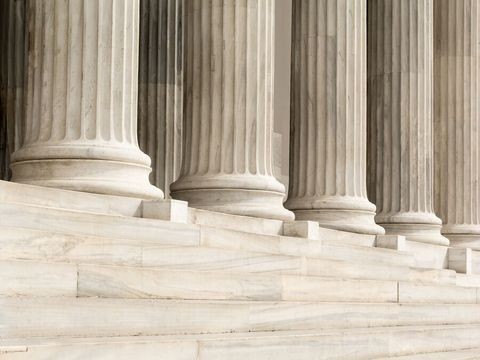Unified Patent Court: Measures for Preserving Evidence
Client Alert | 11 min read | 11.03.15
This is the first alert of a series which will provide practical information and professional comment on all the ramifications regarding the introduction of the Unified Patent Court (UPC). For further information, please see our UPC leaflet PDF or contact the lawyers listed below. To track Crowell & Moring's UPC alerts, please click here.
Regardless of how strong a patent might be, a patentee cannot successfully invoke it in court without submitting evidence that it is being infringed. This will be no different before the Unified Patent Court (UPC). As there is a lack in virtually all European countries both of a general obligation to disclose and regarding discovery, the classic approach to proving infringement has been to use the national equivalent of the measures for preserving evidence mentioned in Article 7 of Directive 2004/48/EC of 29 April 2004 on the enforcement of intellectual property rights. In some countries, such as the Netherlands, the national equivalent of Article 7 allows for mere preservation of evidence, whereas in other countries, such as France and Belgium, these "saisie" proceedings can be used to access the evidence. In this area, as in many others, the UPC will provide for a mixture of both types of proceedings. This approach raises some practical questions to which Article 60 of the Agreement on a Unified Patent Court (UPC Agreement) and the Rules of Procedure of the Unified Patent Court (Rules of Procedure) 192-198 do not always provide clear answers.
1. Does the UPC system provide for mere preservation of evidence or also for the taking of evidence?
Although Article 60 of the UPC Agreement uses the word "preserve" only, it is clear that the system set out in Rules of Procedure 192-198 (where the word "saisie" is explicitly mentioned), goes beyond the mere preservation of evidence. It is probably closest to the French "saisie" system (the Belgian "saisie" system is far more flexible). Indeed, samples can be taken and infringing goods can be seized, as can materials used in the production and/or distribution of these goods. However, the conditions for obtaining these measures are stricter than in France.
2. Can other parties, besides the patentee or exclusive licensee, also request measures for preserving evidence?
Yes, they can. Rule 192 states that an applicant must be a "party" in the sense of Article 47 of the UPC Agreement, that is:
- The patentee.
- The exclusive licensee (unless the license excludes this right) upon simple notification of the patentee.
- The non-exclusive licensee, provided that the license explicitly grants this right and upon notification of the patentee.
- Any other natural or legal person, or anybody entitled to bring actions in accordance with his or her national law, if that person is concerned by the patent in question.
From a strategic point of view, it is interesting to note that a counterclaim in nullity against a licensee is not possible unless the patentee joins the proceedings (Article 47(5) of the UPC Agreement).
3. Where, when and in what language should you file an application for measures to preserve evidence?
Article 60(1) of the UPC Agreement and Rule 192.1 confirm that the application can be lodged either during or prior to proceedings on the merits. If during proceedings, it should be lodged at the division where the applicant has commenced infringement proceedings on the merits. If prior to proceedings, the applicant should address the division where it intends to start proceedings on the merits (if the central division would not be competent, this will typically be the division competent for the territory in which the infringement occurred or in which the infringer is located).
The texts do not indicate if, based on the evidence that is discovered, the proceedings on the merits can be lodged before another division. If the discovered evidence leads to the conclusion that another division is a more appropriate forum, it seems only logical that such a change of division be allowed (to the extent that there is no exclusive jurisdiction of a specific division).
If the application is lodged during proceedings on the merits, then it should be drawn up in the language of the pending proceedings. If lodged prior to proceedings, Rule 14 will apply. In essence this means that the application will have to be drawn up in (one of) the language(s) of the local/regional division in question. If it is before a central division, it will have to be drawn up in the language of the patent.
4. Will the UPC provide a template for the application?
Although this might have been a good idea, such a template was not foreseen. However, Article 60 of the UPC Agreement and Rule 192.2 do specify what should be mentioned in the application:
- Name and full contact details of the applicant and the defendant.
- If the applicant is not the patentee, it will have to prove it is entitled to file the application (see Q2 above).
- The patent(s) that is/are invoked to justify the application.
- Information about any prior or ongoing proceedings relating to the invoked patent(s).
- Identification of the competent division and a justification as to why it is competent.
- A clear indication of the measures that are requested, including the exact location of where the evidence to be preserved is located.
- The reasons why the requested measures are required to preserve relevant evidence.
- The facts and, if available, the evidence on the basis of which the decision was taken to file the application.
- When proceedings on the merits have not yet been initiated, the essential contents (facts and evidence) of the writ of summons that will initiate these proceedings.
It is clear that the burden on the applicant is much higher than that which is currently imposed in a case of saisie in France or Belgium. However, when a saisie is requested ex parte under the UPC Agreement, the burden becomes even higher. Rule 192.3 states that the applicant has to list all the reasons why its application should be decided ex parte. In that regard, Rule 197 hints that an ex parte decision might be appropriate where the delay caused by a contradictory debate might cause irreparable harm to the applicant. The risk of evidence being destroyed or becoming unavailable is also mentioned as a reason to handle the application ex parte. To ensure that the division decides whether or not to handle the application ex parte with complete knowledge of the matter, the applicant is required to disclose any material fact which might influence the division’s decision in that regard.
Although, or rather, because the Rules of Procedure are silent on certain practical points, it is advisable within the application to ask the Court to explicitly rule on the following points: that the order will not be served by the Registry of the Court, but by the person carrying out the saisie; that a copy of the report filed with the Court by that person will be communicated at the same time to the parties; that it be specified who should keep samples, seized items, etc. while awaiting the outcome of the proceedings on the merits, etc. The rules do not even seem to exclude the seizing party from suggesting who should carry out the saisie.
5. How long will it take to get an authorization once the application is filed?
The short answer to this question is that a decision will be handed down "as soon as practicable". The factors that will have an impact on the duration of the examination of the application are not under the applicant’s control.
If no proceedings on the merits have been initiated yet, a first, time-consuming, element is that the Registry has to proceed to a preliminary formal examination of the application: is the patent opted out, are the elements that need to be mentioned (see Q4 above) present in the application, has the correct language been chosen and has the court fee been paid? If the applicant has not fully complied with these conditions, then it can make use of the 14 days cure period to satisfy the inspectors.
After this formal examination, the assigned judge will examine the request on its merits. There are four possible decisions in the event an application has been filed: the saisie can be granted without hearing the defendant; the judge can decide to hear the defendant; or to hear the applicant; or to hear both parties. Although this hypothesis is not explicitly described in the Rules of Procedure, it should be assumed that the judge would also be able to simply reject the application, even without hearing any party. If the Court decides to involve the defendant in the debate, it will inform the applicant. The applicant then has the option to withdraw the application. That same option is offered if a protective letter has been filed. A copy of the letter will be sent to the applicant once the application for a saisie has been filed.
Taking all this into account, it is very difficult to estimate the time it will take to obtain an authorization for a saisie. In cases of extreme urgency the saisie can be applied for without any of these formalities, but it will then be up to the sole discretion of the judge to decide what procedure will be followed.
6. What will the applicant be able to do if the saisie is granted?
First of all, it should be recalled that it is for the applicant to clearly indicate what measures are required. The Court can order a detailed description, if need be accompanied by the taking of samples. The physical seizure of allegedly infringing goods can also be ordered, as well as the seizure of materials and implements used in the production and/or distribution of the alleged infringing goods, and any related documents. It is also possible to obtain the preservation and disclosure of digital media and data, as well as any passwords preventing free access to this information.
Prior to executing the saisie it is possible that a security will have to be paid. Indeed, if the authorization was obtained ex parte, a security will always have to be paid, unless there are "special circumstances". The applicant itself will not be able to do much once the order has been granted. First, because during the execution of the measures the applicant can only be represented by an independent professional practitioner, and on the condition that the Court has explicitly authorized this. In no circumstances may an employee or director of the applicant company be present. Second, the authorization will specify a professional person or expert (for instance a bailiff), who is to carry out the ordered measures and draft a written report on the execution thereof. What the exact content of the report will be, and whether the parties in question will receive a copy, is unclear.
7. Can the saisie be executed as soon as it is granted or are additional steps required?
Despite the fact that Rule 196.3 states that the order to preserve evidence shall be immediately enforceable, it appears that such will not be the case in practice. In fact, the Rules of Procedure seem to lay down the principle that every order has to be served by the Registry of the UPC. This would obviously create an issue if the Registry were to notify a defendant significantly before the execution of the saisie. To avoid the element of surprise being lost, the applicant can ask the Court to rule that the order should not be served by the Registry, but that the person carrying out the ordered measures (Rule 196.4) shall serve the order immediately prior to execution of the saisie. Such an exception seems to be possible under Rule 275, provided that the Court is given "good reason" to authorize service by a method other than passing via the Registry, directly through the judicial officers, officials or other competent persons. The need for surprise and the fact that such a service directly through the judicial officers, officials or other competent persons would be compliant with Article 15 of Regulation 1393/2007 appear to be sufficiently good reasons. Taking into account that the person carrying out the measures will often be a bailiff, or at least be accompanied by a bailiff, the foregoing should not pose any problems.
8. What can be done against the saisie?
To avoid that a saisie is granted or to at least be able to argue against the reasons put forward by the applicant, a party that considers it likely that a saisie will be requested against it can file a protective letter. Although Rule 207 only refers protective letters in the context of an application for provisional measures, it is clear that protective letters are also available in the context of a saisie. Rule 194 indeed explains that the applicant of the saisie can decide to withdraw its application after having been informed that a protective letter was filed. Rule 207 explains what should be mentioned in this document that has to be filed with the Registry in the language of the patent that is at stake. Although Rule 207 states that the arguments in fact and in law, as well as the evidence that should convince the court not to grant the ex parte preliminary relief “may” be mentioned, it goes without saying that these should be mentioned to ensure a maximal efficacy of the protective letter. The Registry will not keep a public register of all the filed protective letters. However, if an application based on the patent(s) mentioned in the protective letter is received, then the applicant will receive a copy of the protective letter. This will allow the applicant to, if need be, reconsider the application and withdraw it. Protective letters ‘expire’ six months after they have been filed, unless a renewal fee is paid. This will prolong the validity of the protective letter with another six months. Further extensions may be obtained on payment of further extension fees.
The order to preserve evidence will indicate that an appeal can be filed with the Court of Appeal within fifteen days after the Court’s decision has been served. If the order was granted ex parte, then the first inter partes discussion is not a hearing in first instance. Such an appeal can be initiated by the applicant, if it did not obtain all the measures requested; by the defendant that was heard prior to handing down the order; or by the defendant that was not heard but was only informed of the application prior to the execution of the saisie.
Contacts
Insights
Client Alert | 5 min read | 12.12.25
Eleventh Circuit Hears Argument on False Claims Act Qui Tam Constitutionality
On the morning of December 12, 2025, the Eleventh Circuit heard argument in United States ex rel. Zafirov v. Florida Medical Associates, LLC, et al., No. 24-13581 (11th Cir. 2025). This case concerns the constitutionality of the False Claims Act (FCA) qui tam provisions and a groundbreaking September 2024 opinion in which the United States District Court for the Middle District of Florida held that the FCA’s qui tam provisions were unconstitutional under Article II. See United States ex rel. Zafirov v. Fla. Med. Assocs., LLC, 751 F. Supp. 3d 1293 (M.D. Fla. 2024). That decision, penned by District Judge Kathryn Kimball Mizelle, was the first success story for a legal theory that has been gaining steam ever since Justices Thomas, Barrett, and Kavanaugh indicated they would be willing to consider arguments about the constitutionality of the qui tam provisions in U.S. ex rel. Polansky v. Exec. Health Res., 599 U.S. 419 (2023). In her opinion, Judge Mizelle held (1) qui tam relators are officers of the U.S. who must be appointed under the Appointments Clause; and (2) historical practice treating qui tam and similar relators as less than “officers” for constitutional purposes was not enough to save the qui tam provisions from the fundamental Article II infirmity the court identified. That ruling was appealed and, after full briefing, including by the government and a bevy of amici, the litigants stepped up to the plate this morning for oral argument.
Client Alert | 8 min read | 12.11.25
Director Squires Revamps the Workings of the U.S. Patent Office
Client Alert | 8 min read | 12.10.25
Creativity You Can Use: CJEU Clarifies Copyright for Applied Art
Client Alert | 4 min read | 12.10.25
Federal Court Strikes Down Interior Order Suspending Wind Energy Development




